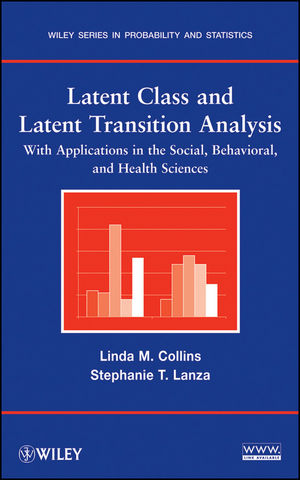Latent Class and Latent Transition Analysis: With Applications in the Social, Behavioral, and Health SciencesISBN: 978-0-470-22839-5
Hardcover
330 pages
December 2009
 This is a Print-on-Demand title. It will be printed specifically to fill your order. Please allow an additional 10-15 days delivery time. The book is not returnable.
|
||||||
List of Tables.
Acknowledgments.
Acronyms.
Part I Fundamentals.
1. General Introduction.
1.1 Overview.
1.2 Conceptual foundation and brief history of the latent class model.
1.3 Why select a categorical latent variable approach?
1.4 Scope of this book.
1.5 Empirical example of LCA: Adolescent delinquency.
1.6 Empirical example of LTA: Adolescent delinquency.
1.7 About this book.
1.8 The examples in this book.
1.9 Software.
1.10 Additional resources: The book’s web site.
1.11 Suggested supplemental readings.
1.12 Points to remember.
1.13 What’s next.
2. The latent class model.
2.1 Overview.
2.2 Empirical example: Pubertal development.
2.3 The role of item-response probabilities to label the latent classes in the pubertal development example.
2.4 Empirical example: Health risk behaviors.
2.5 LCA: Model and notation.
2.6 Suggested supplemental readings.
2.7 Points to remember.
2.8 What’s next.
3. The relation between the latent variable and its indicators.
3.1 Overview.
3.2 The latent class measurement model.
3.3 Homogeneity and latent class separation.
3.4 The precision with which the observed variables measure the latent variable.
3.5 Expressing the degree of uncertainty: Mean posterior probabilities and entropy.
3.6 Points to remember.
3.7 What’s next.
4. Parameter estimation and model selection.
4.1 Overview.
4.2 Maximum Likelihood estimation.
4.3 Model fit and model selection.
4.4 Finding the ML solution.
4.5 Empirical example of using many starting values.
4.6 Empirical examples of selecting the number of latent classes.
4.7 More about parameter restrictions.
4.8 Standard errors.
4.9 Suggested supplemental readings.
4.10 Points to remember.
4.11 What’s next.
Part II Advanced LCA.
5. Multiple-group LCA.
5.1 Overview.
5.2 Introduction.
5.3 Multiple-group LCA: Model and notation.
5.4 Computing the number of parameters estimated.
5.5 Expressing group differences in the LCA model.
5.6 Measurement invariance.
5.7 Establishing whether the number of latent classes is identical across groups.
5.8 Establishing invariance of item-response probabilities across groups.
5.9 Interpretation when measurement invariance does not hold.
5.10 Strategies when measurement invariance does not hold.
5.11 Significant differences and important differences.
5.12 Testing equivalence of latent class prevalences across groups.
5.13 Suggested supplemental readings.
5.14 Points to remember.
5.15 What’s next.
6. LCA with Covariates.
6.1 Overview.
6.2 Empirical example: Positive health behaviors.
6.3 Preparing to conduct LCA with covariates.
6.4 LCA with covariates: Model and notation.
6.5 Hypothesis testing in LCA with covariates.
6.6 Interpretation of the intercepts and regression coefficients.
6.7 Empirical examples of LCA with a single covariate.
6.8 Empirical example of multiple covariates and interaction terms.
6.9 Multiple-group LCA with covariates: Model and notation.
6.10 Grouping variable or covariate?
6.11 Use of a Bayesian prior to stabilize estimation.
6.12 Binomial logistic regression.
6.13 Suggested supplemental readings.
6.14 Points to remember.
6.15 What’s next.
Part III Latent Class Models for Longitudinal Data.
7. RMLCA and LTA.
7.1 Overview.
7.2 RMLCA.
7.3 LTA.
7.4 LTA model parameters.
7.5 LTA: Model and notation.
7.6 Degrees of freedom associated with latent transition models.
7.7 Empirical example: Adolescent depression.
7.8 Empirical example: Dating and sexual risk behavior.
7.9 Interpreting what a latent transition model reveals about change.
7.10 Parameter restrictions in LTA.
7.11 Testing the hypotheses of measurement invariance across times.
7.12 Testing the hypotheses about change between times.
7.13 Relation between RMLCA and LTA.
7.14 Invariance of the transition probability matrix.
7.15 Suggested supplemental readings.
7.16 Points to remember.
7.17 What’s next.
8. Multiple-Group LTA and LTA with Covariates.
8.1 Overview.
8.2 LTA with a grouping variable.
8.3 Multiple-group LTA: Model and notation.
8.4 Computing the number of parameters estimated in multiple-group latent transition models.
8.5 Hypothesis tests concerning group differences: General consideration.
8.6 Overall hypothesis tests about group differences in LTA.
8.7 Testing the hypothesis of equality of latent status prevalences.
8.8 Testing the hypothesis of equality of transition probabilities.
8.9 Incorporating covariates in LTA.
8.10 LTA with covariates: Model and notation.
8.11 Hypothesis testing in LTA with covariates.
8.12 Including both a grouping variable and a covariate in LTA.
8.13 Binomial logistic regression.
8.14 The relation between multiple-group LTA and LTA with a covariate.
8.15 Suggested supplemental readings.
8.16 Points to remember.
Topic Index.
Author Index.



